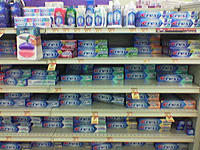When Less is More
 I'm standing in the grocery aisle, scouting for my favorite toothpaste, and notice a perplexed man pacing next to me. I look up and smile. He is scratching his head. Apologetically, he looks up. "My wife told me to get 'Crest regular toothpaste'" he says, "Nothing looks regular to me."
I'm standing in the grocery aisle, scouting for my favorite toothpaste, and notice a perplexed man pacing next to me. I look up and smile. He is scratching his head. Apologetically, he looks up. "My wife told me to get 'Crest regular toothpaste'" he says, "Nothing looks regular to me."I decided to help. However, I soon became mesmerized by rows and rows of Crest toothpaste. I'm not kidding - six shelves stocked with Crest toothpaste - stacked 15 boxes deep, in places...I couldn't back up enough to get them all in this photo!
Not one of the shiny boxes looked like the traditional Crest -- in fact with the exception of a few packaging variations, the toothpastes (rather than the gels or the liquid stuff) looked pretty much the same to us both.
The search for traditional Crest toothpaste got to a point of silliness... Eventually, the man sighed and picked up a box in frustration. He left positive he'd chosen the wrong thing and left to face his wife.
Later on, in a fit of hotel room boredom, I became curious to know just how many types of toothpaste Crest offers. So, I did a little investigation. The Crest website features more than 50 types of Crest toothpaste. Some overlap categories, but here's a rough overview of the product offering:
The list does not include a wide array of toothbrushes, flosses, tapes and rinses which contribute to extra shelf space.
This begs the question: Is more really better? When product choice interferes with a customer's ability to find a product they really like, maybe it's not such a good thing!
I learned this important lesson early on, when I was helping establish the interactive services division for 1-800-FLOWERS. In one of our 16 online stores, we had placed 30+ arrangements within a single product category (birthday). The products in each category had varying price points - from $19.99 to $150.99, yet our conversion rates were low, and we noticed we were taking a lot of web-generated calls asking for assistance with birthday orders. So, we ran a test: We limited our category to 10-15 best selling arrangements that offered variety and covered the same price range. The result: Our online order conversions on birthday increased by a staggering 40%.
What we've learned from testing category assortments for consumer products is that many products don't actually equal more conversion. Many similar products within the same price range can often equal confusion -- and overwhelm the customer.
Now, having an assortment of 15 items isn't always feasible or realistic, especially in an era of product proliferation. The lesson there is, where selection is robust, users must have the ability to quickly filter and/or compare by preference to find what they want.
In-store merchandising is a different game than online merchandising entirely. In bricks, a brand's in-store promotion, real-estate domination and shelf positioning are critical. Therefore, if you've got six shelves of product - you've got instant brand positioning and a statistically higher percentage of being chosen by the consumer. Based on the picture above, Crest was certainly winning that battle at my local Giant store. In the end, even though Crest frustrated and confused the customer - they did succeed in getting brand positioning and the sale. :-D
In this era of information and marketing saturation, many of us would logically agree that sometimes, less is more. This sentiment will hold true until you or I fail to find our favorite type of laundry detergent, diet soda, ziplock bag, soup or box of cereal! Then we may become indignant about a lack of choice. ;-D
Subscribe to:
Post Comments (Atom)
FAVORITES
- On Trust & Influence
- Don't be Social Media Sharkbait
- The Social Media Engagement Continuum
- 10 Tips for Twitter Unmarketing
- Five Experience Funamentals
- Experience & Branding: The Three Word Rule
- Get Some Experience Healing!
- Discovering Customer Experience Pitfalls
- Not My Job: The CX Enemy
- Shoe Carnival: Watch Out for Carnies!
- Bathroom Usability
RECENT COMMENTS
SEARCH
LEIGH DURST

I’m Leigh Durst, a 20 year veteran in business, operations, customer strategy, ecommerce, digital & social media and marketing. Simply put, I’m a strategist that helps companies (start-up to blue chip) achieve business shift, create more compelling online and offline experiences. I also write, speak and teach about experience design and next-generation business. I’m a futurist, visionary, strategist, doer and connector with a passion for people and helping others. When I’m not on the road, you’ll find me in the San Francisco bay area, working, beaching it and hanging out with my family and dog.
Labels
Best Practices
CX
Community
Content
Copy writing
Customer Experience Leaders
Customer Relationship Management
Defining Customer Experience Management
Ethics
Group Think
Harassment
Innovation
Plagiarism
Plurk
RESOURCES
Social Media
Social Media Expert
Twitter
UX
Web 2.0
Web Strategy
advertising
air travel
bank experience
bathrooms
branding
brick and mortar retail
charlene li
cottonelle
customer centricity
customer experience
customer experience files
customer experience management
customer experience pitfalls
customer experience; innovation;
customer research
economy
experience best practices
experience file
experience pitfalls
good customer experience
infrastructure
life
marketing
marketng
motherhood
old navy
personal
privacy
reinvention
restaurant experience
retail experience
security
social networking
starbucks
stuck
target
toilet paper
trust agents
trust continuum
usability best practices
user experience
user experience
word-of-mouth



0 comments:
Post a Comment